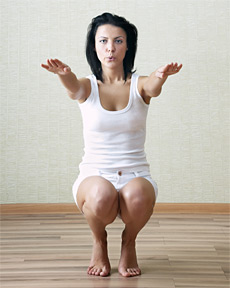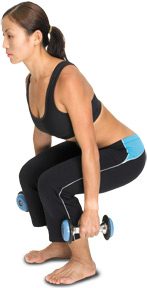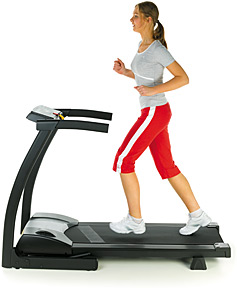For most people, the biggest problem with toning and tightening this area of the body is lack of muscle control and getting rid of the fat layer that sits on top of the muscle. Diet and fat-burning exercise are the keys to losing unwanted inches. Getting your glutes to respond to exercise requires that you understand the muscles. The next important step is to learn to control the muscles while exercising.
 The buttocks are comprised primarily of muscles, although many would argue that their rear ends are completely loaded with just fat. This becomes a main issue for many women since the body chooses to store fat in the area of the buttocks. Eventually, your body can store so much fat in that area it would appear to look like cottage cheese (cellulite). This type of fat is very resistant to diet and exercise, but over a period of time, it is possible to remove cellulite from the body almost completely.
The buttocks are comprised primarily of muscles, although many would argue that their rear ends are completely loaded with just fat. This becomes a main issue for many women since the body chooses to store fat in the area of the buttocks. Eventually, your body can store so much fat in that area it would appear to look like cottage cheese (cellulite). This type of fat is very resistant to diet and exercise, but over a period of time, it is possible to remove cellulite from the body almost completely.
It is also very important to recognize that the body does not “spot reduce.” The exercises listed in this article will tone and tighten the muscles, but you will have to lose body fat all over, including your gluteal area, to achieve your butt-tightening, backside-toning goals.
MUSCLES 101: BUTT BASICS
The main muscles of the buttocks are the gluteus maximus, medius and minimus. These are the three primary muscles, although there are other muscles in this area that are also worth considering: the deep obturators, which are buried deep under the surface; the piriformis muscle (often associated with sciatic pain); and the quadratus femoris.
It is important to learn how to control the buttock muscles – beginning right now! While you are reading this article, start squeezing your buttocks together. That’s right; while you are sitting there, start flexing your butt muscles. Try to flex the right side and then the left. Do you have control yet? It’s pointless to start to begin exercising until you can completely control those glutes.
Learning how to flex the gluteal muscles while you use them will enhance any exercise and result in the use of more muscle fibers. That means faster results. Recruiting more muscle fibers provides a greater response to the stimulus. For some people, this flexing is easy and natural; for others, it is a constant battle.
KEY EXERCISES TO TIGHTEN AND TONE
Camel Walks: This exercise is as old as the hills, but it works. Start with your legs stretched out together on the floor in front of you. It is important to be sitting up straight with your arms crossed (so you don’t use them). Now squeeze your right buttock, then your left, so you can rock back and forth on the buttocks. As you begin to rock, slightly raise your entire right leg and inch it forward, then, as that side is moved forward, rock and squeeze the opposite side. The leg moves forward, then as you rock to the opposite side, the left leg moves. As you do this, you will have the ability to move forward or backward. As you get stronger, you may even be able to hold something (a light weight, a small child) as you’re inching forward and backward.
Free-Standing Squats: Learning to master the basic squat movement is key. Stand with each foot pointed out about 45 degrees. Start the squat by raising your toes slightly off the ground and keeping the lower legs (shins and calves) very still as you push back with your buttocks. Don’t let your knees move forward over your toes. Build tension as you lower yourself down and then coil up (think of the movement in terms of tension on a spring). It helps to stand against a kitchen counter to practice this movement, especially at first. With squats – as with many movements and exercises – it takes balance to achieve success.
Once you’ve mastered the basic movement, place a bench (you can also use a chair) about 12 inches behind your heels. Remember, your chest should stay upright and parallel to the wall while you focus your eyes at a point 10 feet above face level. It’s important for you to determine the point at which the upper legs (between the hips and knees) are parallel to the floor. Keep your weight on your heels; it often helps if you have something to hold on to, since you will often feel as if you are falling backward.
When done properly, the squat recruits maximal involvement of the butt muscles. Learn to keep the muscles flexed in both directions – while lowering into the squat and back raising up. After mastering 50 repetitions, you can work at increasing speed and also add some weight in the form of light dumbbells or a barbell (with or without weight). Don’t add weight until you can master the body-weight squat with perfect form and balance.
It’s important to feel the muscles contract as you lower deeper into the squat. Work on building speed prior to adding weight. Move slowly and take it a workout at a time, one week at a time, etc. Remember, if it’s taken you 10 years to get to this point, it will take some time to get out of the situation your butt is stuck in now.
Step-Ups: To perform this exercise, you need a bench or solid box to step up on, and it should be higher than shin level. For beginners, the box/bench should be at mid-shin level; if advanced, it should be above the knees. Using one leg at a time, place your foot up on the box/bench and step up until both feet are squarely in place at the new height; then step back down to the floor. Now step up again using the opposite foot. As you master the step-up, learn to do the exercise with more spring, and flex the buttocks all the way through the movement, specifically at the top of the movement.
Cardio Flex: Whenever you’re walking, learn to flex your buttocks muscles with every step. In fact, you can do this on any elliptical machine, stair climber or even a bike. This technique can even be done while you are walking or jogging. It is such a simple concept, but learning to flex while you walk forces a much stronger muscle contraction and significantly increases the effectiveness of your workout.
In addition to flexing during cardio, mixing in some exercises during cardio is a great way to tighten up the buttocks and make the muscles respond faster than by simply walking on a treadmill. For example, follow every five minutes of cardio with 50 deep-knee squats. It’s simple, but effective; it mixes up the cardio and forces more muscle stimulus to the buttocks area.
As with any exercise program, the key to success is to start slowly, stay focused, and continually try to improve. Trust me, you’ll see results before you know it if you stay the course. Have fun, talk to your doctor or personal trainer if you have any questions, and enjoy the process.
The Do’s and Don’ts of Proper Squat Performance (in order of importance)
The squat is a key exercise to tone and tighten your backside, but there’s a right way and a wrong way to do them. Here are the “Do’s” and “Don’ts” of proper squat performance; constantly refer to them until you’ve got the proper squat movement down. In the beginning, it might be easier to focus on a few of these recommendations each workout until you’ve memorized them all – covering it all in one day might be too much for you to handle.
- Stand with feet a few inches wider than shoulder width
- Point your toes away from center at 45 degrees
- Keep your toes raised and weight on heels
- Keep your lower shins straight up and down
- Begin by rocking buttocks back
- Slowly lower into the squat and stay flexed
- Keep your chest and eyes up
- Keep the buttocks flexed during the entire movement
Don’t:
- Stand with your feet too close to one another
- Stand with toes pointed straight
- Allow your toes to touch the floor completely
- Let your knees extend past your toes
- Keep your buttocks tucked under you
- Simply drop down to a low position
- Look down to the ground or straight ahead
- Move through the exercise relaxed
Sample Cardio (Treadmill) Programs to Tone and Tighten Your Buttocks
- Walk for five minutes at 3.0
- Do 50 deep step-ups
- Walk for five minutes at 4.0 (incline optional)
- Do 50 deep knee squats
- Jog for five minutes at 5.0
- Do two minutes of camel walks
- Walk for five minutes at 4.0
Cardio Program #2
- Walk for five minutes at 3.0
- Do 50 deep step-ups
- Lunge on the treadmill for five minutes at 2.5
- Do 50 deep knee squats
- Jog for five minutes at 5.0
- Do five minutes of camel walks; then walk for five minutes on full incline at 3.0
- Walk for five minutes at 4.0
By Dr. David Ryan

